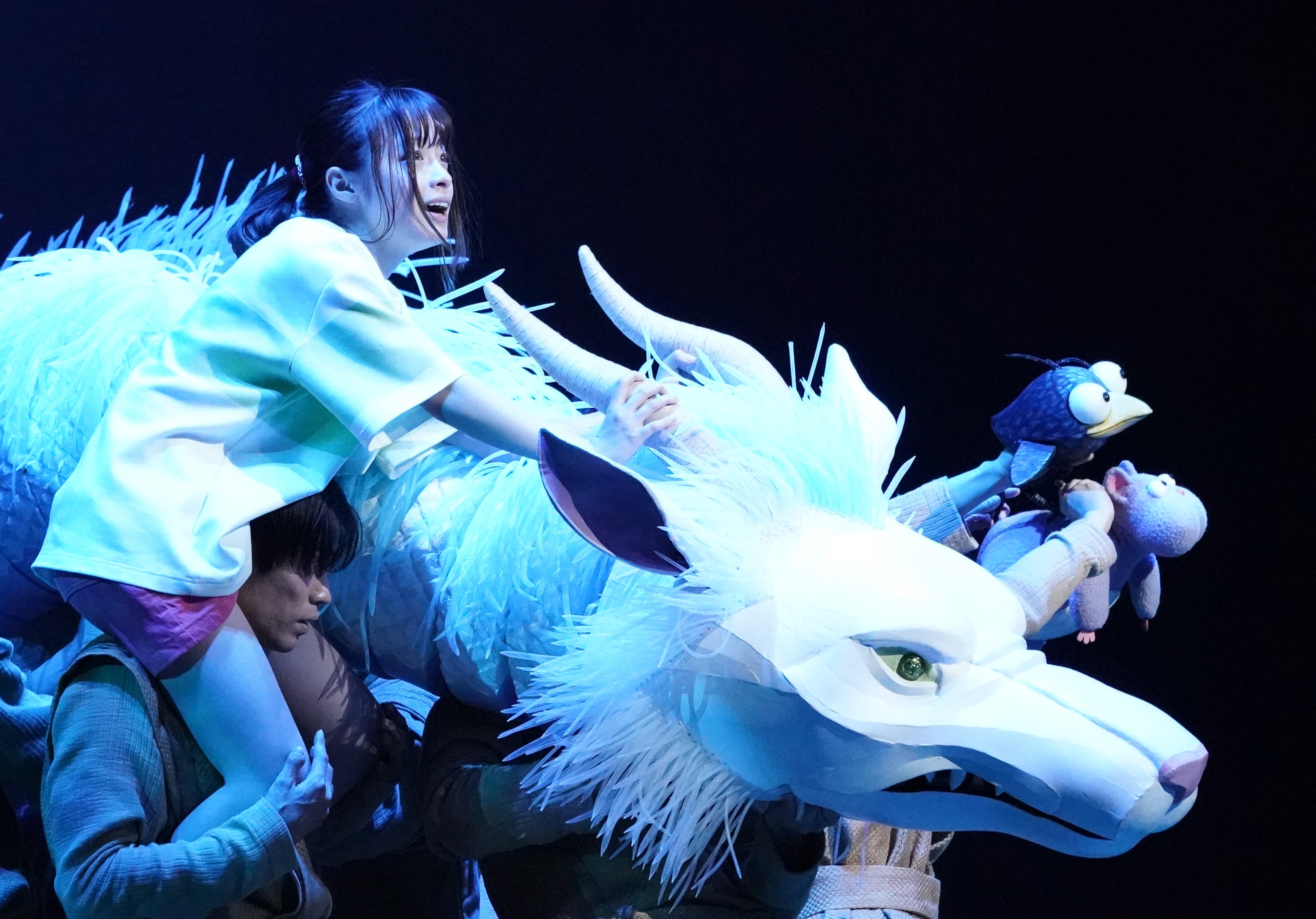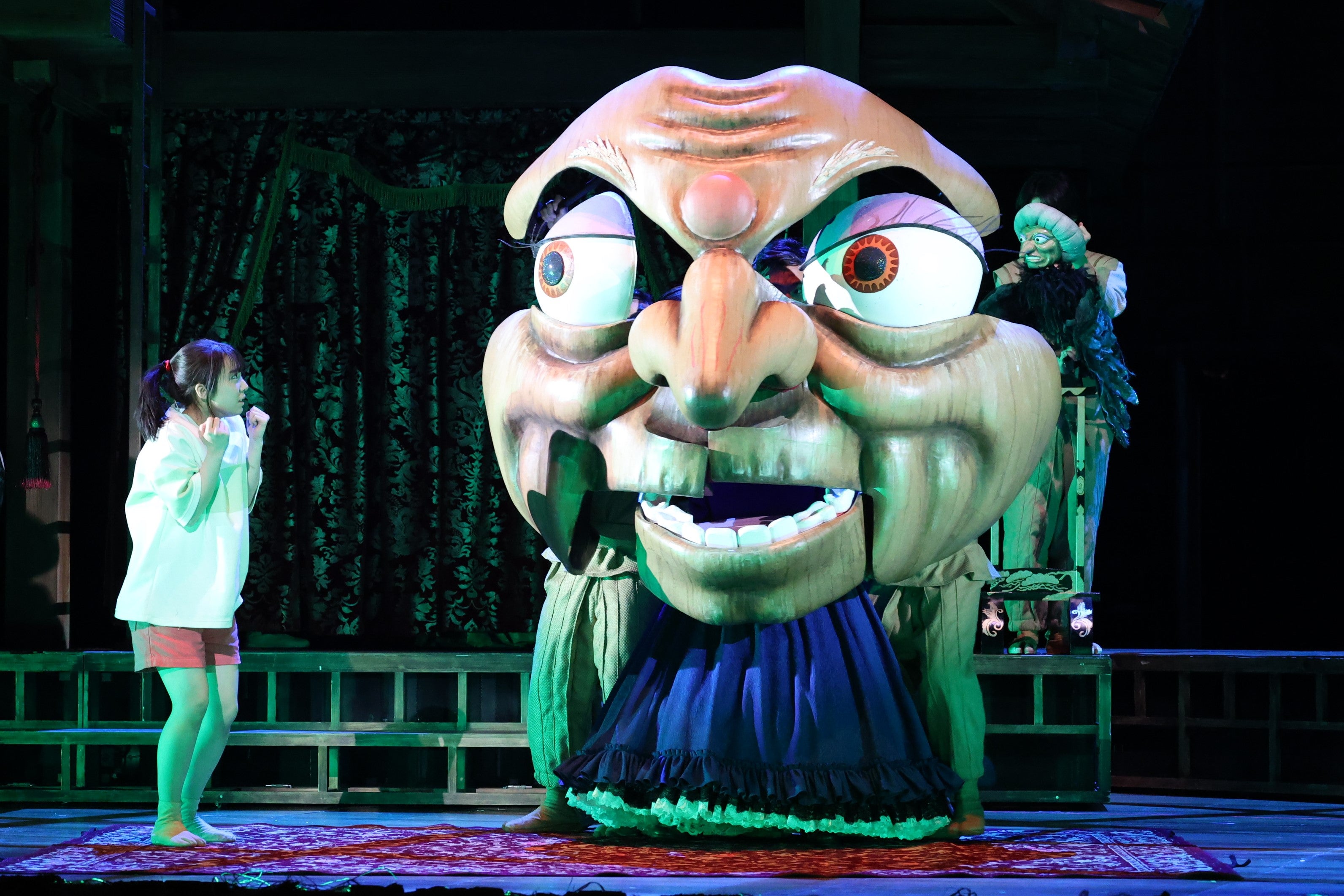Watching the stage play adaptation of Hayao Miyazaki’s Academy Award-winning, animated masterpiece Spirited Away is a surreal experience. The Studio Ghibli film gets brought to life (literally!) through bunraku puppetry, incredible sets, and astounding practical effects, creating an incredibly faithful adaptation that’s simultaneously original. Also amazing: it was written and directed by John Caird, one of England’s most acclaimed playwrights. With recorded performances about to hit U.S. theatres beginning this weekend, we spoke to Caird about this seemingly impossible task of bringing Spirited Away to the stage.
Rob Bricken, io9: What’s your history with the original movie?
John Caird: I just loved it when it first came out. My wife is Japanese, and we have three half-Japanese children and so I’ve been steeped in Japanese anime culture for a very long time. And when Spirited Away came out, I was just astounded by it. I thought it was not just the best animated movie I’d ever seen, it was one of the best movies I’d ever seen. It’s such a great work of art, so I’d always admired it and it never occurred to me to try to make a theatre piece out of it. That came much later, but I’ve always thought it was beautiful. I’ve seen it countless times.
io9: When did the idea of adapting it as a play occur to you, and what gave you the idea?
Caird: It was 2018 — something like that — and I was searching for new ideas to put into the Imperial Theatre in Tokyo which is a very big space that Toho owns and they’re always looking for big projects to go in it. And I was thinking, you know, what’s the next big musical going to be? And then I thought, well, what about doing a big play in that? That, and suddenly it occurred to me, you know, usually I’d been doing big Western stuff in there and I thought, let’s do something Japanese. What could we do that’s a really, authentically Japanese story? And then I thought, well, the great storyteller is Miyazaki. So which one of his movies would do it? And as I trawled through them, I thought, well, there’s only one really that will work in the theatre and that was where the choice came.

io9: What do you think makes Spirited Away Miyazaki’s best work for a theatrical adaptation?
Caird: Because of the simplicity and beauty of the story, and the dynamic of the relationship between the characters — the protagonist characters especially, Chihiro, Yubaba, Kaonashi [called No-Face in the English version] — it’s such a dramatic story, and it has such a beautiful ending. But there’s also the fact that 90 per cent of the film is in one place, and so you don’t have a lot of jumping around. You don’t have to be in an aeroplane, you know, like a lot of Miyazaki’s movies. He’s so obsessed with flight. And so basically, I thought if we can find a way of doing the bathhouse on stage, we’re halfway there.
io9: Spirited Away is also arguably Miyazaki’s most visually fantastical work, and I was astounded watching it come to life on stage. How challenging was it to bring to life on the stage?
Caird: Yeah, I mean, my opening remarks every day of rehearsal were “And the next impossible thing we have to do is…” Every day, you know, on every page of the script — the script is about 70 to 80 pages long — and on every page, there are three impossible things that you have to do. But it was a joy in the end, solving those problems with those actors, those dancers, my design collaborators, my choreographer. It was like being in a play school for eight weeks. It was fantastic fun.
io9: According to the Toho Theatre, where Spirited Away ran, you came to Miyazaki with the idea of adapting the movie. Is that correct?
Caird: That’s right. Yeah.
io9: They also said Miyazaki accepted your pitch for the stage adaptation very quickly, but he’s notoriously a bit of a grump and protective of his films. What do you think you said that convinced him so quickly?
Caird: I just got the feeling he got me, you know — that the things I said about the movie and the way I described his movie back to him just, I guess, must have made him feel he was in safe hands. I didn’t find him grumpy at all. He was absolutely charming. He was completely sweet and almost sort of grateful that his movie was even being considered to be worthy of being a theatre piece.

io9: That’s wonderful. It’s been a while since I’ve seen the movie, but the stage play does seem incredibly faithful to the original as I remember it. Is that correct?
Caird: Pretty much, yeah. I still have enormous respect for the dramaturgy of the film. I think it’s incredibly tight, the way he tells the story with pictures. There’s a wonderful edition of five little books [containing] each frame of the film, and my designers and I used that as a sort of bible. This is what’s telling the story. This is the image that we need to go to next. So how do we find a way of doing that? And if we don’t do this image, what are we doing instead of this image to take us on to the next? And of course, there are lots of omissions we made. We chose not to show certain things because we didn’t think they were germane. Most of the time we just trusted Miyazaki’s sense of drama and just followed what he’d shown us with his incredible artwork.
io9: That’s understandable. Is Spirited Away considered a bunraku puppetry play, or kuroko, those black-clad assistants who handle things on stage and are understood to be invisible? Because the play has both, although the kuroko are wearing beige.
Caird: I don’t know. It’s an interesting hybrid, certainly, but I think it’s just a play. I wouldn’t know how to describe it other than it’s just a great play, maybe. What was it J.M. Barry called Peter Pan? A fantasy in five acts. Maybe Spirited Away is a fantasy, you know? It’s got that dreamlike quality of the fantastical brought to life, but it is a combination of Western culture and Japanese culture, and Shinto vision comes deeply into it because of the gods and the way the gods intercede with humans.

io9: The special effects are incredible. I’m thinking especially of Yubaba, whose head gets giant when she’s mad in the movie. You had several actors, each holding part of her face, bringing the individual pieces together to form the whole. Is there some kind of precedent for that in Japanese theatre that inspired this technique?
Caird: That it was an idea entirely dreamt up by Toby Olié, my lovely puppetmaster. It’s completely brilliant. I was astonished when he showed me the drawings of it. I asked, “Is that going to work?” And then we did a workshop of it in London with some British puppeteers, and it just came together, like, “Wow, that is astonishingly funny.” I have to take my hat off to him.
io9: There are two different filmed versions of the play coming to U.S. theatres because there are two separate casts. I understand why Chihiro would require two actors because it’s a role for a younger actor who’s on stage for almost the entirety of the play. But why double-cast the other principal roles?
Caird: Well, it’s interesting. It’s a tradition that’s grown up in Japan, and I started it when I did Les Misérables there years ago. We had two actors who were playing Javert and Valjean. Partly because they do so many performances a week in Japan and it’s too exhausting, especially in a musical it’s exhausting to sing.
But even in a play like Sen to Chihiro [Spirited Away’s original Japanese title], it’s really exhausting to play that number of performances. And if you did, you’d have to have understudies anyway. So rather than, you know, people who aren’t quite up to it coming in and understudying if somebody gets sick. It’s much better to have two teams of principals that can play together.
It also means that Japanese audiences want to buy tickets for more than one performance, so it’s a sort of marketing tool as well. They want to see not just both the Chihiros, but they want to see all the. different combinations of actors so they can say, “Oh, I thought Kanna [Hashimoto’s Chihiro] was best with Hiroki [Miura’s Haku]” or “Oh, I thought Mone [Kamishiraishi’s Chihiro] was best with Mari [Natsuki’s Yubaba].” And it’s part of the tradition of theatre-going in Japan now.

io9: Oh, I didn’t realise that. Have you used two casts in any of the works you’ve staged in Europe?
Caird: No. One of the reasons it would be difficult to do in England or America is that English and American actors hate the idea of sharing a role with anybody else because you know that role, that’s my role. I’m playing it. Whereas in Japan, collaboration is deeply written inside the culture. They’re used to collaborating at a very deep level. It’s part of the national consciousness, if you like. The two Chihiros sit together at the same desk. And the two Yubabas sit together at the same desk in rehearsals and share notes about how to achieve what they want, and they managed to do that and still be very different from each other.
io9: Did you make Spirited Away with the hopes of touring it internationally or making an English-language version?
Caird: I would love that to happen. Certainly, it would be great. I’d love to share this production with as many people around the world as we can, but at the moment I can’t say there are definite plans about it. But it would be great.
io9: Do you have a message for the American fans who are finally getting a chance to see the stage play?
Caird: I hope it pleases them, I hope it gives them some pleasure, especially fans of the movie and fans of Ghibli, who hold Miyazaki’s work precious in their hearts. I hope I haven’t done any damage to their expectations.
io9: I can assure you, at least from my perspective, you have not.
Caird: That’s very kind. Thank you so much.
